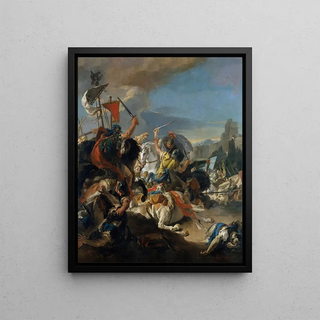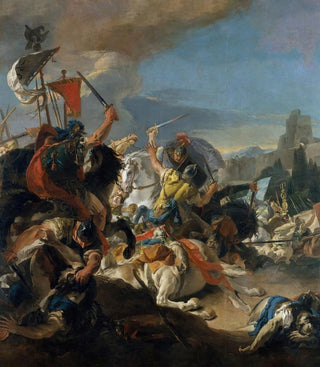Art print | The Battle of Vercellae - Giovanni Battista Tiepolo


View from behind

Frame (optional)
La bataille de Vercellae, painted by Giovanni Battista Tiepolo, is a work that transcends the simple frame of art to immerse the viewer in a bygone era where heroism and drama intertwine. This painting, which depicts a significant historical scene, evokes not only a military event but also a reflection on power, glory, and the consequences of war. In this representation, Tiepolo manages to capture the very essence of the struggle, skillfully blending movement and emotion, while inviting the viewer to explore the rich and vibrant details of this narrative fresco.
Style and uniqueness of the work
Tiepolo's work stands out for its masterful use of light and color, elements that infuse a unique dynamism into the scene. The characters, animated with palpable intensity, seem to emerge from the painting to lead the viewer into the depicted epic. The composition, both complex and harmonious, guides the eye through the different levels of action, revealing tensions and interactions among the protagonists. The drapery of the costumes, crafted with meticulous care, adds a sculptural dimension to the whole, while the stormy skies in the background reinforce the idea of a tumultuous conflict. This mastery of detail and visual storytelling makes La bataille de Vercellae an iconic work of the rococo style, where exuberance and theatricality unite to create an immersive atmosphere.
The artist and his influence
Giovanni Battista Tiepolo, an emblematic figure of the 18th century, is recognized for his ability to fuse baroque art with a lighter, more playful approach to rococo. His career, marked by prestigious commissions across Europe, bears witness to his lasting influence on the artistic landscape. Tiepolo was not only a court painter but also an innovator who knew how to breathe new life into history painting. His bold use of perspective and vivid colors paved the way for many artists who followed. Through his works, he managed to capture the imagination of his time, while

Matte finish

View from behind

Frame (optional)
La bataille de Vercellae, painted by Giovanni Battista Tiepolo, is a work that transcends the simple frame of art to immerse the viewer in a bygone era where heroism and drama intertwine. This painting, which depicts a significant historical scene, evokes not only a military event but also a reflection on power, glory, and the consequences of war. In this representation, Tiepolo manages to capture the very essence of the struggle, skillfully blending movement and emotion, while inviting the viewer to explore the rich and vibrant details of this narrative fresco.
Style and uniqueness of the work
Tiepolo's work stands out for its masterful use of light and color, elements that infuse a unique dynamism into the scene. The characters, animated with palpable intensity, seem to emerge from the painting to lead the viewer into the depicted epic. The composition, both complex and harmonious, guides the eye through the different levels of action, revealing tensions and interactions among the protagonists. The drapery of the costumes, crafted with meticulous care, adds a sculptural dimension to the whole, while the stormy skies in the background reinforce the idea of a tumultuous conflict. This mastery of detail and visual storytelling makes La bataille de Vercellae an iconic work of the rococo style, where exuberance and theatricality unite to create an immersive atmosphere.
The artist and his influence
Giovanni Battista Tiepolo, an emblematic figure of the 18th century, is recognized for his ability to fuse baroque art with a lighter, more playful approach to rococo. His career, marked by prestigious commissions across Europe, bears witness to his lasting influence on the artistic landscape. Tiepolo was not only a court painter but also an innovator who knew how to breathe new life into history painting. His bold use of perspective and vivid colors paved the way for many artists who followed. Through his works, he managed to capture the imagination of his time, while






